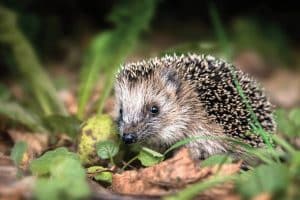Many gardeners are often thinking about how to attract more creatures to their plot through nectar-rich plants, bird food and good garden practices.

But what if you are killing your wildlife with kindness? Are you unwittingly putting out the wrong scraps for animals, creating a pond in which creatures become trapped, or tidying your garden to the detriment of nests and sheltering spots?
Here are some common mistakes gardeners make when trying to be kind to wildlife, and advice from experts on how to keep wildlife safe.
DON’T… Serve up fat balls in plastic netting
Peanuts and fat balls are regularly sold in nylon mesh bags. Never put out any food in mesh bags, the RSPB (rspb.org.uk) advises. These may trap birds’ feet and even cause broken or torn off feet and legs. Birds with a barbed tongue, such as woodpeckers, can become trapped by their beaks.
Instead, hang a half coconut filled with fat balls in a tree or from a bird table, the RSPB advises.
DON’T… Feed birds dodgy seed mixes
The RSPB advises bird lovers to avoid seed mixtures containing split peas, beans, dried rice or lentils, as only the large species can eat them dry. They are added to some cheaper seed mixes to bulk them up. Any mixture containing green or pink lumps should be avoided as they are dog biscuit, which can only be eaten when soaked.
Poor quality peanuts can carry the aflatoxin fungus, which can kill birds if they eat it. Instead, make sure you buy peanuts that are guaranteed aflatoxin-free from a reputable supplier. And buy seed mixes from a reputable source such as the RSPB, checking which species the mix is likely to attract before you buy.
DON’T… Use pesticides
Many gardening experts agree that chemical pesticides are mostly non-specific, so will destroy beneficial insects as well as the nuisance ones, which will then start to upset the balance of nature. Instead, go organic and opt for different methods. You can use beer traps or hand-pick slugs and snails off your plants after a downpour, wipe or wash aphids off badly affected plants as they appear, and use parasitic nematodes as a biological control for vine weevil.
DON’T… Cut hedges at the wrong time
Resist cutting hedges and trees between March and August, as this is the main breeding season for nesting birds, although some birds may nest outside this period, says the RSPB.
DON’T… Box creatures in
You may love seeing creatures visit your garden, but wildlife is not a pet, and should be free to roam in and out of the garden. So don’t box wildlife in with mile-high fencing – a hedgehog, for example, needs to walk a mile a night searching for food and a mate.
Instead, create safe corridors from your garden to the one next door, by making gaps at the base of your fence.
Also, let some of your lawn grow longer. Voles, shrews, frogs, toads, beetles and hedgehogs like to move through long grasses rather than out in the open, the RSPB advises.
DON’T… Tidy your garden too much
If you remove all your leaves and other garden debris from your beds and borders, you’re effectively depriving any visiting wildlife from shelter and food.
Instead, tidy up (if you have to) in spring, when wildlife is waking up rather than going to sleep. And at least plant some strong perennials such as Sedum ‘Herbstfreude’ whose seed-heads will be left standing when you prune the rest, to provide birds and insects with shelter and food.
When pruning, save some of the bigger branches and logs to make a log pile in a quiet, sheltered part of the garden, which will provide insects with a haven in the cooler months.
DON’T… Let creatures drown
Yes, wildlife will always be attracted to water, but getting in and out of a pond can be tricky if the pond has a hard edge that sits above the water level. Hedgehogs, for instance, are adept swimmers, but if they can’t climb out of steep-sided ponds or pools, they will drown. Instead, use a pile of carefully positioned stones, a piece of wood or some chicken wire to create a simple ramp to allow creatures to exit, Hedgehog Street (hedgehogstreet.org) suggests.
DON’T… Give milk to hedgehogs
You may be tempted to treat your visiting hedgehog to a bowl of milk instead of water, but it doesn’t agree with them and can cause diarrhoea, says the RSPCA.
DON’T… Think that only the most showy blooms will attract insects
Flowers that come from intensively bred plants, with huge double flowers, may not offer much to visiting insects in the way of nectar. Instead, go for good nectar plants including foxgloves, wallflowers, Verbena bonariensis and heleniums, as well as herbs including chives, borage and rosemary. For a list of nectar-rich plants visit the RHS (rhs.org.uk) .
(Story source: Silver Surfers)

